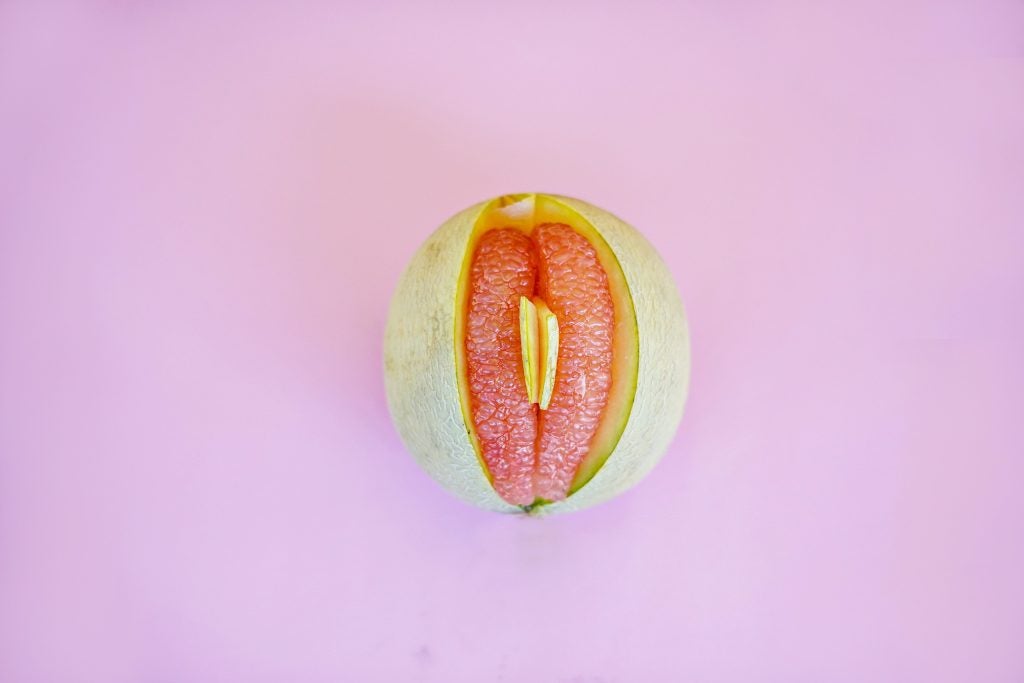
A labiaplasty is a surgical procedure that involves reducing the length of the labia. The labia minora is often the focus of a labiaplasty, while the labia majora can also be surgically reconstructed. The procedure is minimally invasive, which is why labiaplasties have been increasing in popularity. One of the goals of the procedure is to maintain the color and texture of the labia. The labia of some females can experience hypertrophy, or overgrowth, which can cause physical or emotional distress.1 Labiaplasties can be done for aesthetic purposes to reduce any excess skin while resizing the labia to appear symmetrical.1 Labia hypertrophy can cause irritation, as the labial skin is erotically sensitive so friction with tight-fitting clothes can be uncomfortable and may affect one’s daily life. More serious effects of excess labia tissue include urinary tract infections and difficulty maintaining hygiene. There is no widely accepted medical standard for what labia hypertrophy is, so it is up to the discretion of an individual and their doctor to discuss the patient’s symptoms are and if those symptoms constitute surgery. Patients typically desire a prepubescent aesthetic, where the labia minor is within the labia major instead of protruding out. Labiaplasties are usually successful and typically have a high patient satisfaction rate.1
Table of Contents
How Labia Hypertrophy Occurs
A common misconception about labia hypertrophy is that individuals with the condition have had numerous sexual partners. Labia hypertrophy has multiple causes including pregnancy, aging, and genetics.2 Pregnancy can be a strenuous process for the labia minora and labia majora as skin can become stretched and may not return to its pre-pregnancy state.2 Pregnancy is also associated with significant weight gain for some females, which can lead to the accumulation of fat around the female genitalia.2As one gets older, body-wide loosening of skin may occur, but this can be prevented limiting ones time in the sun. Genetic predispositions can lead to labia hypertrophy; some are born with excess labial tissue, while others are genetically inclined to develop excess labia.2 Mechanical factors also play a role in excess labial skin. Biking, horseback riding, and genital piercings can cause an individual to develop labia hypertrophy.2
Reasons for a Labiaplasty
Every surgeon has different criteria to determine if a patient is able to have a labiaplasty and what type of surgery will be performed. A labiaplasty can be done for psychological or physiological reasons. Individuals who desire aesthetic labia surgery may be self-conscious about the appearance of their genitals, as their genitalia do not fit their notion of normal. Not all individuals who desire labial rejuvenation are insecure, but many individuals seek to reduce anxiety about sexual encounters with new individuals and to increase self-esteem.2 There are numerous misconceptions about labial hypertrophy and many derogatory terms used to describe the condition. Some women with this condition are called “loose,” which increases negative associations with labial hypertrophy.2 Irritation of the labia by clothing is a common problem that a labiaplasty can solve. Tight-fitting clothing can be especially irritating and may cause chronic pain as the excess skin rubs against clothes. This irritation cause an individual to focus on insecurities involving the labia even more. There can also be discomfort with excess labia during intercourse. Every labia is different and the appearance of the female genitalia is affected by genetics, mechanical factors, and childbirth. There is no labia length that medical professionals have deemed “normal”, but if one feels uncomfortable with the length of their labia, they can discuss the matter with a trained medical professional. Surgery is not the only solution to reduce anxiety and increase self-esteem about excess labia skin, but a labiaplasty can be beneficial to individuals who desire rejuvenation.
How a Labiaplasty Is Performed
The first labiaplasties removed excess tissue from the labia using the trim method. The trim method reshapes the labia and removes tissue from the outside regions. This method also removes any darkly pigmented tissue around the labia.3 Current and more advanced techniques employ the use of lasers which are much more accurate than using a scalpel like the trim method does. In addition, lasers reduce healing time, stiffness, and discomfort.3The wedge method is an improvement on the trim method that utilizes a cut across the width of the labia instead of the edge. The wedge method is beneficial for reducing the appearance of scars.3 The Z-incision is an improvement on the wedge technique which employs a zig-zag incision to reduce scarring and to tighten the labia after healing.3 Each surgery has different steps and methods that are used, but a simple trim technique begins with local anesthesia.3 After sedation, the patient is positioned with stirrups. Stirrups are supports that position an individual with open legs for a gynecological exam or childbirth. The frenulum is then marked with a sterile marker, and the patient is injected with anesthesia. Scalpels, scissors, or lasers are common tools for making incisions, but each surgeon decides what tool they are most comfortable with. The surgeon then makes cuts based on their chosen technique. Although this scenario is a basic overview of a labiaplasty, there are many more techniques and intricate steps being utilized during an operation.
Recovering from Labiaplasty
A labiaplasty is an outpatient procedure, which means the patient can return home the same day, so the recovery process is relatively easy, provided there are no complications. Patients who undergo a labiaplasty are usually released from the hospital the same day; sometimes they are released as little as an hour after the surgery is completed. Swelling and itching are common side effects which typically last two to three days after surgery, but they decrease over time. Bruising in the region is normal and should be expected.4 There should be minimal pain and itching after a week of surgery.4 Icing can help to reduce swelling, but remember to never apply ice directly to the skin as prolonged exposure to ice can be harmful to skin.4 Patients are allowed to return to normal activity three to five days after a labiaplasty procedure, however it is advised that they refrain from using tampons, avoid wearing tight or irritating undergarments, and abstain from sexual activity for at least six weeks. It is likely that a surgeon will schedule a post-operation appointment with the patient within the proceeding two months. Complete results of a labiaplasty will appear about four to six months after surgery.5
Risks

Risks of a labiaplasty include infection, permanent changes in sensation, constant pain, and scarring.1 A very common risk associated with having any cosmetic surgery is the possibility that the outcome will not be what the patient expected. Vaginal surgery can be very safe if a trained and experienced surgeon performs it. An individual can discuss their expectations and goals with a doctor so that the patient and doctor can both be satisfied. A doctor can discuss any possible risks to their patient to reduce any stress about the operation and to explain any serious risks.
Costs
The cost of a labiaplasty is dependent on a variety of factors. The geographic location of the surgical center can dictate the price that a patient may pay.6 For example, a labiaplasty in Beverly Hills, California is likely more expensive than the same surgery in the suburbs of Minneapolis, Minnesota. The surgeon an individual chooses is another major factor in the cost, as a reputable surgeon may be more expensive. The extent to which the labia needs to be repaired is a significant indicator of price because if more work is required of the surgeon, the price of the procedure will likely be higher.6 Combining procedures such as rejuvenating the clitoris, labia minora, and labia majora can be much more expensive than a labiaplasty alone. A labiaplasty alone can cost anywhere from $3,000 to $8,000.6 Insurance typically does not cover a labiaplasty unless the labia hypertrophy is causing significant distress to the health of the patient.6
Concluding Remarks
Labiaplasties can be beneficial procedures for many individuals if a trained medical professional administers them. There is not just one reason to have a labiaplasty as individuals have the procedure done for self-esteem reasons, while others desire to get rid of discomfort associated with excess labial skin. Labiaplasties have become increasingly popular due to the minimal invasiveness of the procedure. Complications from the procedure may occur, but they are rare. A labiaplasty is a quick procedure that typically results in positive experiences and a relatively easy recovery period.
Resources
- Gowda, Arvind U., Nikki Chopra, and Marwan Khalifeh. Advances in Pediatrics. U.S. National Library of Medicine, 2015.
- “Labiaplasty and Labia Minora Reduction: Background, History of the Procedure, Problem.”Medscape Drugs & Diseases – Comprehensive Peer-reviewed Medical Condition, Surgery, and Clinical Procedure Articles with Symptoms, Diagnosis, Staging, Treatment, Drugs and Medications, Prognosis, Follow-up, and Pictures. N.p., 27 July 2017.
- “PlasticSurgeons.com.” Advantages and Disadvantages of Reconstructive Surgery. N.p., n.d.
- Tannan, Shruti. “Four Common Questions Women Have about Recovery after Labiaplasty.”American Society of Plastic Surgeons. American Society of Plastic Surgeons, 17 Jan. 2018.
- “Vaginoplasty and Labiaplasty.” WebMD. WebMD, n.d.
- “How Much Does a Labiaplasty Cost – Beverly Hills – Las Vegas.” J. Timothy Katzen, M.D.N.p., 26 Feb. 2014.
Last Updated 22 May 2018.
